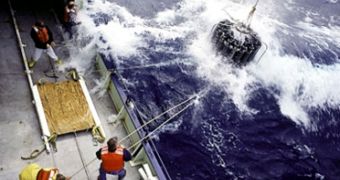A team of researchers in the United States believe that analyzing the natural sounds produced by the ocean could be used as a method of detecting changes in some of its basic traits, such as for example temperature, salinity, current disposition and seafloor topography.
The oceans are renowned for their variability, in the sense that each of these characteristics tends to shift regularly, but not in patterns. As they do so, they exert an influence on the way oceans sound like.
This happens because changes in any of these parameters influence the way sound waves travel through the water. Understanding this phenomenon could have a variety of practical applications.
For example, conducting ocean science investigations, naval operations, and underwater robotic vehicle studies could become a lot easier, says the research team behind the work.
A detailed analysis of how oceanic sounds are produced could also inform the design of advanced submarines, that would be extremely stealthy and hard to detect when submerged.
Robots used to plug oil leaks could also find it a lot easier to navigate and operate in the dark waters of the deep ocean, the Massachusetts Institute of Technology (MIT) group says.
Calibrating sound wave-based systems used for basic oceanographic and climate research could also become easier. Scientists in Taiwan and at the Woods Hole Oceanographic Institution (WHOI) contributed to the new study as well.
The research itself was conducted off the costs of Taiwan and Kauai. Conclusions obtained from these real-world experiments were then compiled in complex theoretical computer models, the team says.
Scientists were surprised to discover unexpected changes in the sound waves-ocean interference near the edge of continental shelves, which is where the slope of the seafloor undergoes massive changes.
The research effort was conducted by the MIT Department of Mechanical Engineering Doherty Associate Professor in Ocean Utilization, Pierre Lermusiaux.
“We’re just trying to advance the science and technology,” the expert says. He adds that experts now have ways of predicting the propagation of sound waves through various regions of the ocean.
The research also yielded more insight into the degree of uncertainty associated with those predictions, and allowed the experts to cross-reference the theoretical results against real-world experiments.
Details of the investigation appeared in the November 30 online issue of the esteemed IEEE Journal of Oceanic Engineering.
“This paper confirms unequivocally that ocean acoustic uncertainties are connected to a detailed knowledge” of how oceanic features interact at specific locations and times,” says University of Bologna professor of oceanography Nadia Pinardi.

 14 DAY TRIAL //
14 DAY TRIAL //